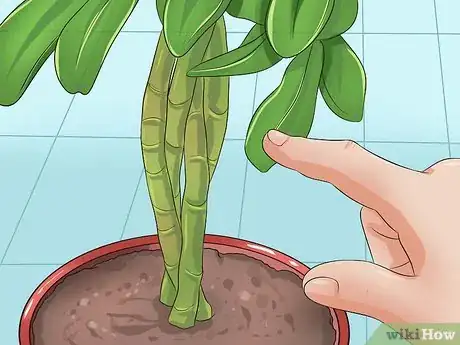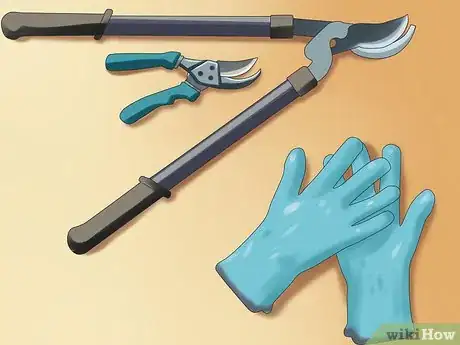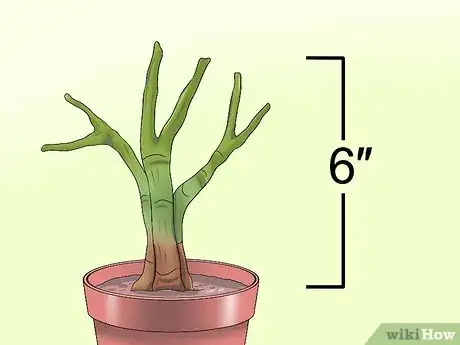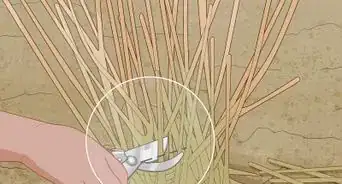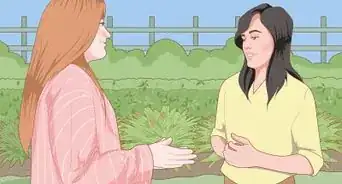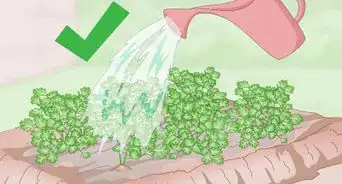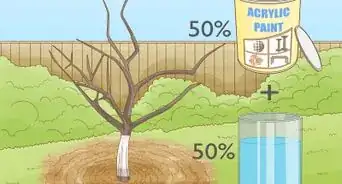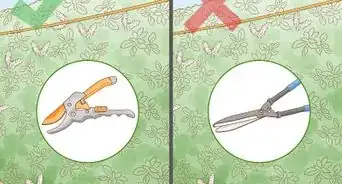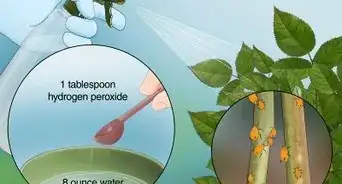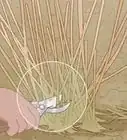This article was co-authored by Maggie Moran. Maggie Moran is a Professional Gardener in Pennsylvania.
There are 8 references cited in this article, which can be found at the bottom of the page.
wikiHow marks an article as reader-approved once it receives enough positive feedback. This article received 23 testimonials and 92% of readers who voted found it helpful, earning it our reader-approved status.
This article has been viewed 404,304 times.
Schefflera, or Umbrella plants, are common houseplants that are easy to grow because they can thrive in artificial or moderately bright light conditions and are susceptible to few pests. However, they may require pruning if they get too large or scraggly. [1] Here’s how to prune your schefflera. The process is really quite simple.
Steps
Assessing Your Plant
-
1Examine your schefflera to see if it has a single stem or several stems. This will influence how you go about pruning your plant. Schefflera with multiple stalks usually give you more options when pruning. They can grow in fuller and bushier, as they just have more places for leaves to grow. Schefflera with only one stalk may be more suitable for developing a tall thin plant.
- Keep the natural shape of your plant in mind when trimming. Fighting the natural growth pattern of your plant will be more difficult than simply shaping and trimming it as it grows.
- This is especially important to look at when you are buying a new plant. If you want a full, bushy plant, be sure to pick a schefflera that has multiple stems so it will fill in and expand outward and upward. If you want a plant that will grow taller and stay relatively slim, pick a schefflera with only one stem (and trim any other stems that might pop out of the soil).
-
2Determine how you would like the plant to look immediately and in the future. Some people want a tall and skinny plant, while others would like a short and bushy plant. It all depends on where you would like your plant to live and how much care you can give it. Part of trimming a plant is deciding how you want it to grow and helping it along that path.
- On a schefflera the growth nodes, the place on a stem where new growth can develop, are located at the point on the stems where the leaves sprout. Because the schefflera usually has abundant growth and many nodes at which to trim, thinking about how it will grow in the future when assessing where that plant needs trimming will help you to promote growth in specific directions.[2]
- Make this decision before cutting any leaves! Have a plan before you start so that you avoid mistakes and trim too many leaves.
Advertisement -
3Check the general condition of your plant. Before trimming your plant make sure that it is suitably potted and healthy. Make sure that your plant is in good soil and that the soil is moist. Before trimming your plant you may even want to take the opportunity to repot it, if you suspect its roots are crowded and you want to promote growth.
- You should also check to make sure the leaves are healthy. If the leaves are looking discolored or getting brown spots you may need to address some problems, either with over watering or a lack of nutrients in the soil. Schefflera should not be kept in super moist soil. Allow the soil to dry out between waterings. If this does not improve the condition of the plant, you may want to replace the soil it is potted in.
EXPERT TIP“If you notice an unhealthy looking stalk or damaged leaves, that’s a good indication that you should prune your plant.”
Maggie Moran is a Professional Gardener in Pennsylvania.
Maggie Moran
Home & Garden Specialist Maggie Moran
Maggie Moran
Home & Garden Specialist -
4Get your tools ready. Always be sure to use sharp and clean tools when pruning. For schefflera plants, the tools you’ll need really depend on the plant and its size. Hand pruners, shears, and loppers will work for most small shrubs. However, schefflera can grow to be large – as tall as 40 feet (12.2 m)! For larger plants, you may need to use a pole pruner.
- Consider calling a professional pruning service if the tree is too large to handle safely with a pole pruner.
Trimming Your Plant
-
1Reduce the height of a schefflera plant by cutting an upright stem just above a growth node. In other words, trim it right above where a leaf has sprouted. Trimming off the growing tip of a stem will prevent it from quickly gaining height and will promote a fuller appearance in the area you cut.
- Use bypass type pruning shears, the kind of pruning shears that cut with two blades, just like scissors. Other types of shears have a tendency to crush stems, as opposed to cutting cleanly through them. [3]
- Sometimes unwanted height in a schefflera is caused by a lack of light. The plant is basically growing up to try to find more light. Keep this in mind when finding a suitable place for it to live.
-
2Reduce the width of a schefflera by cutting any horizontal branches back to just above a leaf node. Keep in mind that you will get renewed growth at the node where you cut, so you may want to cut the plant back further than you currently desire, in anticipation of it filling in in the future. Schefflera can really handle some aggressive pruning, so don't be afraid to give it a good haircut!
- Once again, use bypass type pruning shears so that you do not crush the stem.
-
3Cut all stems down to 6 inches from the base to rejuvenate a bare bottomed, straggly plant. Sometimes these plants get neglected and become horribly overgrown and if you cannot figure out a way to shape the plant through gentle pruning, you can trim it all the way down. This give your plant a fresh start and it will give you the opportunity to better control how it grows in the future. Don't worry, it will grow back with a vengeance if it is given enough light, moisture, and nutrition.
- When trimming your plant back, make sure to leave 2 to 3 nodes on each stem. This will give the plant ample spots at which to form new growth.
- The large pieces you have cut off your plant would make great cuttings for propagating new plants. Place a cutting with at least two layers of leaves into moist soil for a few weeks. This will give the cutting enough growth nodes to keep growing. Roots should sprout from the bottom of the cutting and the plant can then be repotted.
Expert Q&A
Did you know you can get expert answers for this article?
Unlock expert answers by supporting wikiHow
-
QuestionCan you take cuttings from a Schefflera?
 Maggie MoranMaggie Moran is a Professional Gardener in Pennsylvania.
Maggie MoranMaggie Moran is a Professional Gardener in Pennsylvania.
Home & Garden Specialist
-
QuestionHow often should I water my umbrella plant?
 Maggie MoranMaggie Moran is a Professional Gardener in Pennsylvania.
Maggie MoranMaggie Moran is a Professional Gardener in Pennsylvania.
Home & Garden Specialist
-
QuestionHow do you take care of a Schefflera plant?
 Maggie MoranMaggie Moran is a Professional Gardener in Pennsylvania.
Maggie MoranMaggie Moran is a Professional Gardener in Pennsylvania.
Home & Garden Specialist
Warnings
- Eating the leaves of a schefflera plant can be poisonous to dogs and cats. Make sure they are out of reach for your pet's health and safety. [6]⧼thumbs_response⧽
References
- ↑ http://www.guide-to-houseplants.com/schefflera.html
- ↑ http://pubs.ext.vt.edu/430/430-459/430-459.html
- ↑ http://www.nytimes.com/2010/05/13/garden/13roadtest.html?_r=0
- ↑ http://www.shmoop.com/plant-biology/primary-secondary-growth.html
- ↑ http://www.bonsaihunk.us/info/ScheffleraBonsai.html
- ↑ http://www.petpoisonhelpline.com/poison/schefflera/
- Hessayon, Dr.D.G., The Houseplant Expert, London, England, Expert Books, 1994, pg. 205
- Editors, Sunset Magazine, Sunset National Garden Book , Menlo Park, CA, Sunset Books, 1997 pg.491
About This Article
To prune a schefflera plant, use pruning shears to trim the stem right above a growth node where a leaf has sprouted. Then, to reduce the width of the plant, cut back the horizontal branches just above a growth node so that new growth will be fuller and healthier. If your plant has become very scraggly and unhealthy, trim the stems and branches back so they’re very short, leaving only 2 or 3 nodes on each stem. For tips from our Horticulture reviewer on how to use these trimmings from your schefflera plant to propagate new ones, read on!
